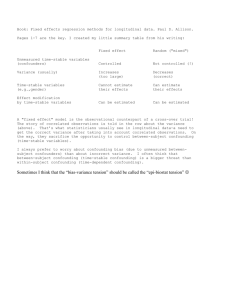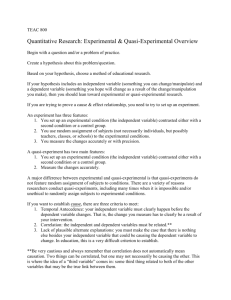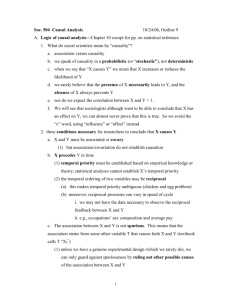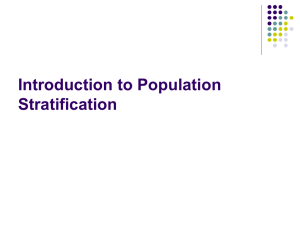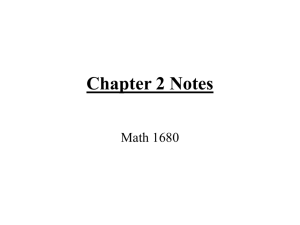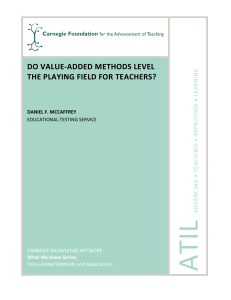Research Methods in - HomePage Server for UT Psychology
advertisement
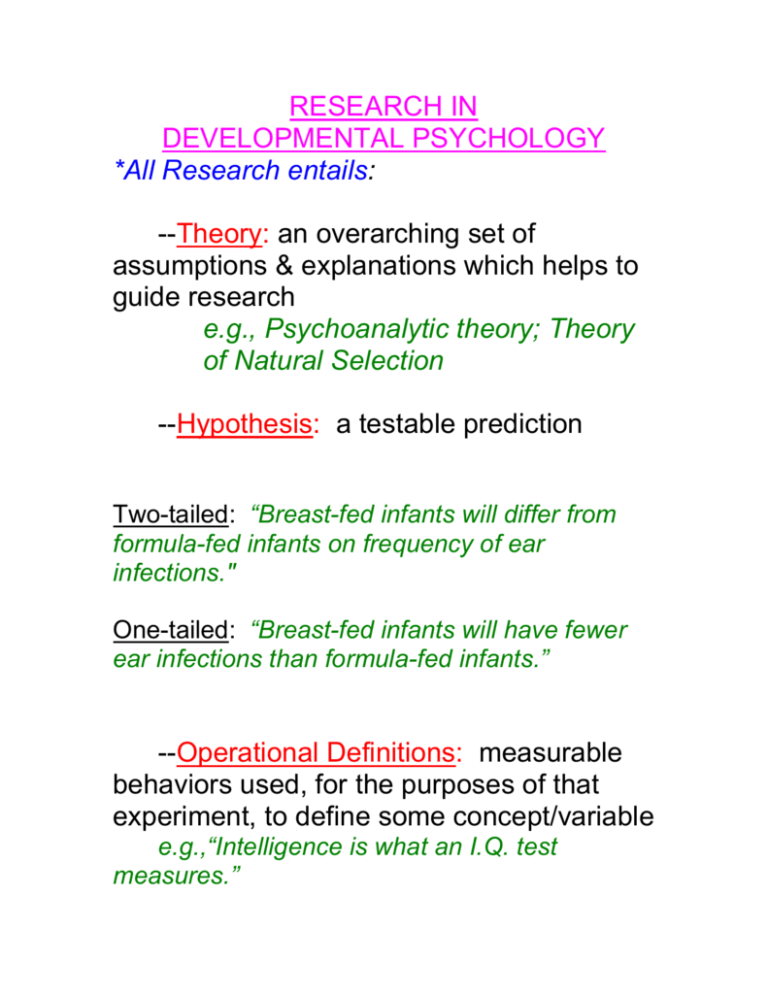
RESEARCH IN DEVELOPMENTAL PSYCHOLOGY *All Research entails: --Theory: an overarching set of assumptions & explanations which helps to guide research e.g., Psychoanalytic theory; Theory of Natural Selection --Hypothesis: a testable prediction Two-tailed: “Breast-fed infants will differ from formula-fed infants on frequency of ear infections." One-tailed: “Breast-fed infants will have fewer ear infections than formula-fed infants.” --Operational Definitions: measurable behaviors used, for the purposes of that experiment, to define some concept/variable e.g.,“Intelligence is what an I.Q. test measures.” --Sampling of a Population Random sampling vs. unbiased sampling I. Descriptional & Correlational Research *CANNOT infer cause-effect *No manipulation of variables –includes Naturalistic Observation, Case Studies, Survey/Self-Report, etc. --Correlational Research assesses the relationship between two (or more) variables, based either on an active study, or archival material (e.g., the U.S. Census) Correlation Coefficients have 2 parts: a. number, from 0.00 to 1.00 b. sign: positive or negative (neg. a.k.a. inverse) --Number indicates strength of the relationship: 0.00 - 0.29 weak relationship 0.30 - 0.69 moderate 0.70 - 1.00 strong --Sign indicates direction of relationship: Positive means high X, high Y, etc. Negative means low X, high Y and vice versa II. Regression Analyses --statistical technique that examines the relationship between a dependent/ response variable and multiple independent / explanatory variables For example, NICHD day care study examined whether attachment of child to mother most affected by: --number of hours day care/week --age at which child began day care --responsiveness of mother --sex of child --demographic factors III. Experimental Research *CAN infer cause-effect, because isolation of causal variables: --manipulate potentially causal variables --control potentially confounding variables A. Laboratory Research 1. Types of Variables Independent: what experimenter manipulates (or manipulates levels of) Dependent: behavior, etc. that is being measured as a function of the independent variable Subject: any traits, variables that an individual brings to the experiment, e.g., sex, birth order placement, I.Q., had a working mother Confounding: any variables which, because of poor research design, or insufficient control, may alter results 2. Between- vs. Within-subject designs a. Between-Subject Design --Experimental vs. Control groups --random/unbiased assignment into groups b. Within-Subject Design (a.k.a. Repeated Measures design) --all subjects receive all conditions --counterbalance order of conditions, to eliminate practice & fatigue effects c. Factorial Designs --Two or more variables (may be any combination of between, within, or subject variables) --allows detection both of main effects and Interactions COPE ratings are ratings of congressional votes. A high COPE rating indicates prolabor votes. Each observation is a member of congress. Suppose that you want to determine if COPE ratings vary by political party and by region of the country. You also want to test for an interaction between region and party. Assume two variables: PARTY & REGION B. Field Experiments 1. Exactly the same as lab experiments, but conducted in the field (a natural setting) WANTED: Undergraduates to participate in a neuropsychology experiment. Participants will receive $2000 upon completion of experiment. The study involves severing some parts of the brain to see what types of cognitive or behavioral impairments occur. It is expected that the findings will have implications for cognitive science, and may generate useful therapies for those who have suffered strokes, etc. IV. Quasi-Experimental Research --cannot manipulate “independent” variable because of ethical or practical concerns A. Standard Quasi-Experimental Designs 1. "Independent" variable is usually a subject variable--sex, I.Q. level, from divorced vs. intact family; autistic children, brain-damaged, lived through 9/11/01 in NYC 2. Participants cannot be randomly assigned into groups 3. Dependent measures may still be designed scientifically, control of confounding variables, etc. B. Developmental Research 1. Longitudinal: same subjects studied over a period of time (even years) Film Example: Seven Up! (Paul Almond), Seven plus Seven (Michael Apted, henceforth), Twenty-One, 28 Up; 35 Up, 42 Up, 49 Up “Give me a child until he is seven and I will give you the man.” -Francis Xavier Upper Class Boys: John**, Charles*, Andrew Upper Class Girl: Suzy Working Class Girls: Jackie, Lynn, & Sue Cockney Boy: Tony Charity Home children: Paul, & Symon (only black participant) Yorkshire Lad: Nick Neil (later suffers from mental illness) Peter* (classmate of Neil’s; has dropped out) Bruce a. Pros: -see patterns of individual development -fewer subjects needed -each subject serves as his/her own control (fewer confounding var.) b. Cons: -Non-representative sample because: a) Self-selection of those willing to participate b) Selective Attrition c) Only a single age group might be studied, leading to a cross-generational problem (results don’t transfer to other generations) -Age/History confound (due to cultural or historical events, not to age), e.g., favorite decorating colors 2. Cross-Sectional: Different age groups (or cohorts) are compared on some behavior a. Pros: --quick & less expensive b. Cons: --Cohort effects: results due to social or historical backgrounds of subjects in each cohort, not to age/development e.g., political beliefs on flag burning of people at 20, 40, 60 3. Sequential: Combination of longitudinal & cross-sectional techniques used--several cohorts also studied longitudinally C. Ethics of Research 1. Informed Consent: people must be given enough information about what they (or their children) are to do, to give consent 2. Confidentiality: participants’ identities should not be revealed, including identifying information 3. Protection from Harm: researchers have the responsibility to protect participants, and to \ minimize their discomfort whenever possible 4. Benefits to Risk Ratio in approval of research: is the potential benefit to society or the individual is sufficiently greater than the risk to the individuals who participate D. Summary Statistics 1. Mean: Average of a set of scores or measurements 2. M______: Most frequently occurring score or measurement 3. M_______: Middle score (after scores have been rank ordered) --When is each measure most appropriate?



